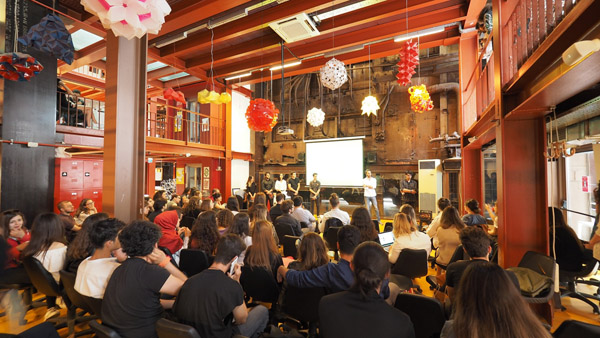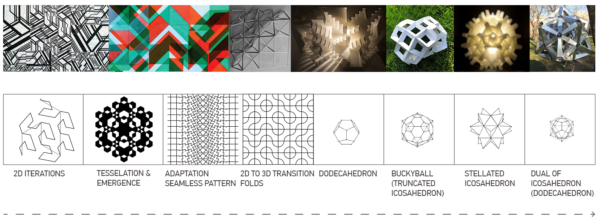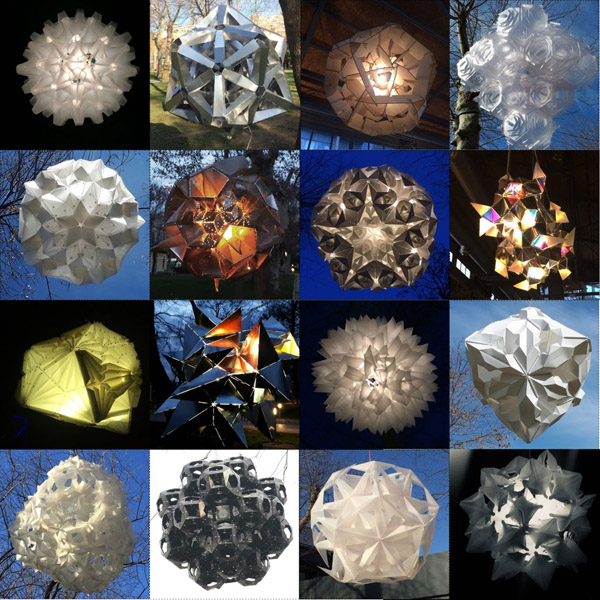Lanterns Project: Computation-based Basic Design Studio
by Tuğrul Yazar | October 4, 2018 14:21
In the first-year Computation Based Basic Design studio at İstanbul Bilgi University, the aim is to help students understand that design, due to its prevalent relational nature incorporates different forms of reasoning as indispensable constituents within the creative process (Yalınay Çinici, 2013). The studio integrates the 1:1 scale construction via computational thinking which consists of geometric relations, material computation/performance, and CAD/CAM technologies. The aim of the studio is to develop an awareness of immediate or far surroundings in terms of shapes, forms, figures, colors, textures, and materials in different scales through abstraction and conceptualization. The same construction method is also applied in two-dimensional tessellations. Tessellations are dealing with the problem of covering an area without gaps or overlaps. Students learn how to create tessellations with increasing complexity by only defining simple geometric rules, such as truncation and duals. Such methods are also re-utilized in the future subject of polyhedra.

Photo: Caner Bingöl
The Computation-based Basic Design studio is structured to explore design space through tasks with gradually increasing complexity, in 2D and 3D by focusing on a hands-on approach through material performance as well as geometric relations. The studio operates on individual critiques based on the tangible work and interpretation of the students to given tasks, by at least three instructors with diverse backgrounds and approaches to design. The collaborative teaching method allows for the creation of an environment of dialogue that is constantly evolving, encouraging students to reflect on their design process. Figure 1 shows the synchronical relationship between the Computation-Based Basic Design Studio and the Design Geometry course. The studio exercises begin with two-dimensional rule-based patterns and evolve into multi-layered and multi-dimensional design systems by applying different materials and production techniques. Before initiating the final project, there are preliminary studies on integrating digital modeling and fabrication of polyhedral shapes and material computation. In the project named “Structural Components”, students are asked to span a predefined distance by combining given pieces of cardboard with predefined dimensions. They are encouraged to think about creating components out of these pieces, by considering their combination potential to seek multiplicity. The structural requirement of the exercise motivates students in creating three-dimensional sections, resulting in research for more complex relationships. This exercise benefits from the pattern deformation study of the Design Geometry course and helps students to elevate the pattern deformations into component-based three-dimensional structures with intrinsic variations. The “Lanterns Inside” was another short-term individual project, aiming to introduce students to the geometric basis of polyhedra, material properties, and joint details. Students analyze and study precedents made of various materials and forms. They experiment with various approaches to achieve three-dimensional and
volumetric outcomes, composed of rule-based component systems. The initial ideas raised from this project are further developed in the final project that fit a larger scale and outdoor conditions.
 [1]
[1]Case Study: “The New Year’s Lanterns”
The individual projects explained above lead to the final assignment of the semester where students work in groups to design and construct a lighting element suitable for outdoor use. Students are encouraged to investigate the geometrical relations, and material performances, and develop custom joinery details considering the effect of light, regarding reflections, shadow, transparencies, etc.

This study is presented at eCAADe 2018 Conference in Lodz, Poland. For the rest of the paper, you can visit here[2]
- [Image]: https://www.designcoding.net/decoder/wp-content/uploads/2018/10/horizontaltimeline3.png
- you can visit here: http://papers.cumincad.org/cgi-bin/works/paper/ecaade2018_312
Source URL: https://www.designcoding.net/computation-based-basic-design-studio-a-case-study-of-lanterns-project/